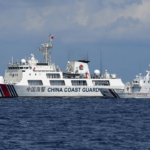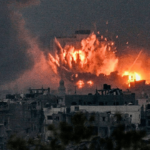The Downfall of Syria: 13 Years of Struggle for Power End to Ruin

After thirteen years, Syria is still at war. One of the worst humanitarian crises of the twenty-first century, bringing Syria, a country rich in historical legacy, to complete collapse. Amidst the continuous turmoil, a number of state-sponsored and non-state organizations have emerged, each contributing to the obstruction of Syria’s development and the enormous exodus of its citizens.
Big Rallies were visible in the divided Idlib region on the occasion of the 13th anniversary of Syrian Conflict, a region under the control of rebels opposed to Bashar al-Assad. Notably, alongside chants against Assad, protestors also voice opposition to jihadist leaders in the area. Currently, Hay’at Tahrir al-Sham (HTS), formerly affiliated with al-Qaida, exerts significant influence over much of the northwest, including Idlib. People don’t find any difference between Assad and separatist now, they all treat them the same. People slowly understand what they wish for and what they fight for will never reach them. Idlib is witnessing a lot of protests as the people discontent, Recent weeks have witnessed numerous protests against HTS leader Abu Mohammed al-Jolani, sparked by the death of an individual while in the group’s custody.
There were protests at the 13th anniversary that took place outside of Idlib as well. Hundreds of people gathered to commemorate the occasion in the government-held city of Sweida in the south. This comes after about seven months of anti-government demonstrations in the wider Sweida region, which is mostly home to the Druze minority in Syria and has up until now mostly stayed out of the conflict.
It all started in March 2011, when nationwide demonstrations against Bashar al-Assad’s government gained traction and resulted in sizable assemblies in favor of democracy. Assad crushed the protest by using force. The intense persecution carried out by the regime sparked the Syrian insurgency and gave rise to armed opposition groups like the Free Syrian Army. By mid-2012, the fighting had intensified and become a full-fledged civil war.
Understanding the multipolar conflict in Syria requires deliberate effort. Various foreign nations, including the United States, Iran, Russia, and Turkey, have provided support to different factions involved. Russia has conducted airstrikes and ground operations in Syria. Meanwhile, the international coalition led by the United States, has primarily focused on combating the Islamic State while occasionally backing anti-Assad forces such as the Syrian Democratic Forces (SDF) and the Revolutionary Commando Army. Turkey, supporting the Syrian National Army (SNA), has controlled parts of northern Syria since 2016 and has engaged in conflicts with the Assad regime, the Islamic State, and the SDF.
The Kurds, a significant factor in the region, have shifted their alliances over time. They are against Turkey and joining forces with the United States against the Islamic State, they also fought alongside the SDF against Assad. In 2019, Kurdish leaders in Rojava, a region within Syria, brokered a significant agreement with the Assad government, prompted by the U.S. withdrawal from Syria. This agreement aimed to secure Syria’s support in repelling Turkish forces invading Syria and targeting Kurds. However, by 2023, the primary military conflict had transitioned from the Syrian government versus rebels to clashes between Turkish forces and factions within Syria.
Turkish forces intensified their attacks on Kurdish forces in the Rojava region, launching airstrikes and ground assaults against the Syrian Democratic Forces starting in October 2023. These actions were purportedly in retaliation for the Ankara bombing, which the Turkish government attributed to assailants from northeastern Syria.
While people died or living in the worst living conditions, Numerous political analysts, military strategists, and journalists strongly believe that the Syrian Civil War is fundamentally rooted in a geopolitical rivalry between Russia and the United States, along with their respective allies in the region, concerning natural gas pipelines traversing Syria en route to European markets. The United States and its allies proposed the construction of the Qatar–Turkey pipeline, aiming to diminish Europe’s reliance on Russian natural gas, particularly crucial during winter months when many European households depend on Russian supplies. Conversely, Russia and its allies sought to thwart this project and instead promote the Iran–Iraq–Syria pipeline.
Syrian President Bashar al-Assad rejected Qatar’s Proposal to construct a $10 billion Qatar-Turkey pipeline through Saudi Arabia, Jordan, Syria, and Turkey. Allegedly, this refusal prompted clandestine CIA efforts to instigate a Syrian civil war, with the objective of pressuring Assad to step down and facilitate the installation of a pro-American leader who would endorse the pipeline deal. Leaked documents from 2009 indicate that the CIA commenced funding and supporting opposition factions in Syria to incite civil unrest.
Russia supports Assad’s opposition to the Qatar-Turkey pipeline, favoring the promotion of the Iran-Iraq-Syria pipeline, which would bolster Russia’s allies and enhance Iran’s economy. However, such business ventures in Syria have come at a significant human cost. The United States needed only some dates to start the project. There was hate fuming in Syria on Assad’s Addiction to power. Taking advantage of the situation, the United States has raised the Syrian Democratic Forces and other factions to challenge Assad’s regime.
There are suspicions that even the Islamic State might have been a product of US intelligence, akin to the Taliban in Afghanistan. In this volatile scenario, various parties have vested interests: Turkey, Israel, Russia, Iran, everyone has blood on their hands.
Syria has undergone fragmentation, with various entities asserting control and pursuing their own interests. The Assad regime still holds sway over most of the territory, officially recognized as the Syrian Arab Republic, and maintains influence in key cities like Damascus. Assad’s support network includes powerful allies such as Russia, Iran, China, and surprisingly, some Arab nations including Saudi Arabia.
In northeastern Syria, the independent Administration of North and East Syria (AANES), also known as Rojava, serves as a de facto independent entity. Rojava aspires to autonomy inside Syria’s federal and democratic structure, not total independence. The area is divided into autonomous sub-areas that include Afrin, Jazira, Euphrates, Raqqa, Tabqa, Manbij, and Deir Ez-Zor. In the midst of the ongoing Rojava conflict in 2012, it gained de facto autonomy, with the Syrian Democratic Forces (SDF), the country’s recognized armed force, playing a crucial role.
The region has widespread support for its dedication to independent, pluralist, egalitarian, feminist, and universal democratic ideals in discussions with different groups and parties. Significant Kurdish, Arab, and Assyrian communities coexist with lesser ethnic Turkmen, Armenian, Circassian, and Yazidi populations in northeastern Syria, which has a diversified population.
If the Autonomous Administration of North and East Syria (AANES) succeeds in facing various challenges, including authoritarian tendencies, corruption, conflicts with Turkey, Kurdish forces, and Islamic State factions, there could be a possibility of a Syrian partition akin to the examples of Germany, Vietnam, and Korea. This scenario might entail a split between a Russia-backed Assad-controlled Syria and a West-backed AANES-controlled Syria.
Apart from the Assad and Syrian Democratic Forces (SDF) administrations, there exists the Syrian Interim Government (SIG), established by the National Coalition for Syrian Revolutionary and Opposition Forces, serving as an alternative governance structure in Syria. The SIG claims to be the sole legitimate government representing the Syrian opposition, challenging the authority of the Council of Ministers of the Syrian Arab Republic. Headquartered in Azaz, Aleppo Governorate, the interim government exercises indirect control over certain areas within the country. Turkey is in support of SIG and the weird United States who already made the situation complex also supports SIG sometimes.
The Syrian Free Army (SFA), also known as the New Syrian Army (NSA) or Revolutionary Commando Army, is a Syrian opposition faction that controls territory near the Jordan–Syria border. It has received training from the United States Army and has been stationed at al-Tanf. Established as an expansion of the Allahu Akbar Brigade by defectors from the Syrian Arab Army and other rebels during the Syrian Civil War, the New Syrian Army aimed to drive out the Islamic State from southeastern Syria.
The Syrian Salvation Government, established in early November 2017 in Idlib Governorate, serves as a de facto alternative to the Syrian opposition’s governance. It was formed under the leadership of the Hay’at Tahrir al-Sham (HTS) rebel coalition. Following its inception, tensions emerged between the Syrian Salvation Government (SSG) and the Syrian Interim Government (SIG), leading to reports of HTS unilaterally dissolving several SIG-supported local councils across northwestern Syria. While HTS officially declares its independence from the civilian administration of the Salvation Government, labeling their relationship as a “partnership” aimed at providing security and an alternative to the Ba’athist government, some analysts challenge this assertion. They argue that HTS maintains control over the SSG’s security and economic sectors, using the SSG as a political facade.
Interestingly, these opposing factions do not cooperate or attempt to form a unified government, despite not being opposed to the idea of a united Syria. While major opposition factions with ties to the United States receive financial or military assistance, they fail to forge alliances among themselves. This raises suspicions about the true interests of the United States in the region, especially as Russia remains steadfast in supporting Assad’s official government. As we delve deeper into the situation, questions arise about the possibility that the Islamic State’s foreign vehicles and weapons may not be coincidental.
The once prominently featured brutality of the war has now given way to an uneasy stalemate. As aspirations for regime change diminish and peace negotiations prove fruitless, some regional governments are reconsidering their opposition to engaging with Syrian leader Bashar al-Assad. With the government reclaiming control over much of the country, Assad’s grip on power appears increasingly secure.
The conflict has taken a devastating toll, with estimates ranging from 470,000 to 610,000 violent deaths, making it the second deadliest conflict of the 21st century after the Second Congo War. International organizations have accused all involved parties—including the Assad government, IS, opposition groups, Iran, Russia, Turkey, and the U.S.-led coalition—of severe human rights abuses and massacres. This war has led to a significant refugee crisis. The number of refugees may have surpassed 6 million with the majority moving to Turkey. Across the political spectrum in the country, refugees have faced considerable blame, particularly for exacerbating the economic downturn. And all over Europe they are not welcomed like Ukrainians.
Syria remains without a visible political solution. the urgent need to prioritize peace efforts to counteract the dire trends afflicting the nation. The UN estimates that 16.7 million Syrians will require humanitarian assistance or protection this year, marking the highest figure since the conflict began. Nearly 90% of Syrians live in poverty, according to UN data. UNICEF reports that almost 7.5 million children in Syria will require humanitarian aid in 2024.
A harsh punishment meted out to those who desire a democratic government.




